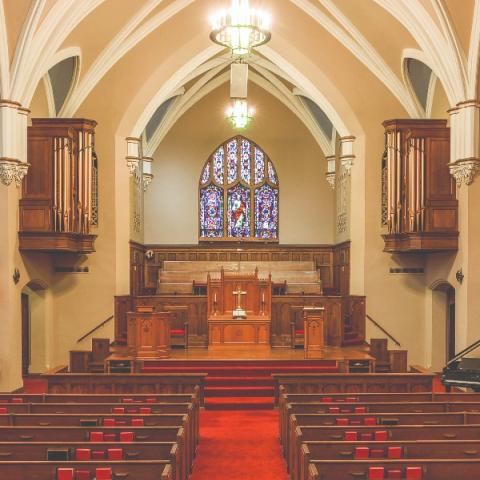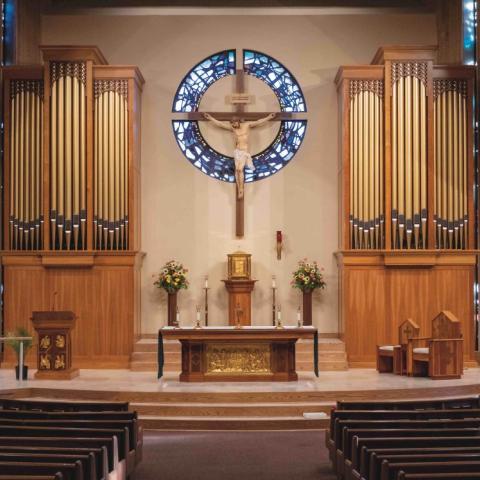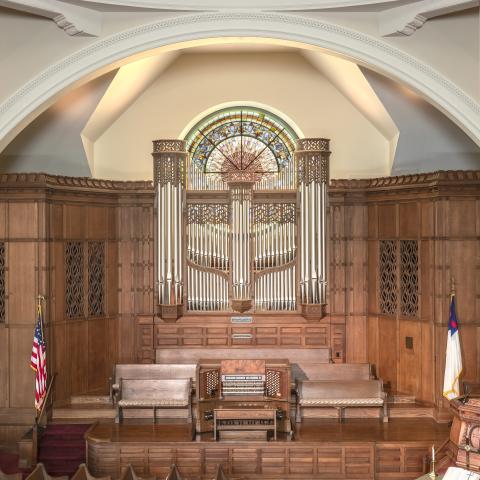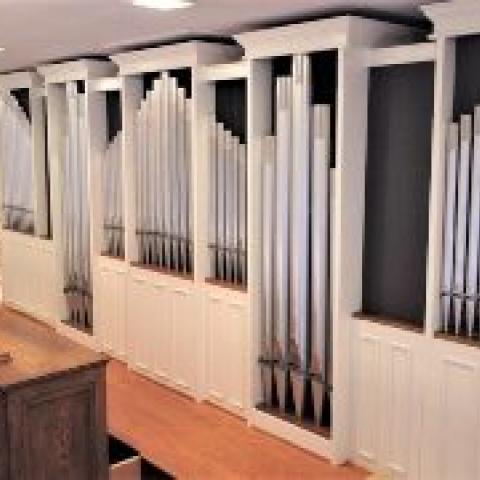
Muller Pipe Organ Company, Croton, Ohio
Saint Patrick Catholic Church, Columbus, Ohio
Muller Pipe Organ Company has installed a new two-manual, twenty-two-rank organ at Saint Patrick Catholic Church in Columbus, Ohio. The instrument utilizes select pipework from the church’s former organ—a 1935 Schantz—plus the façade and casework of an earlier Odell/Roosevelt instrument. The Schantz organ was typical for 1935 and served the parish for many years. In the 1980s, an ambitious plan of restoration and expansion commenced. A three-manual console was installed to accommodate several tonal additions that would “complete” the instrument, but the additions ultimately went unrealized.
Within the last decade, discussions about an organ project were reinitiated by Kathleen Tully, director of music of the parish. After considering a variety of options, it became apparent that, though the organ was beloved, it needed more color and the ability to support congregational singing. The favored approach was to establish a new tonal concept capable of supporting a wide variety of singing, to create a new organ mechanically, and to retain several signature sounds of the existing organ.
The new instrument is rooted in centuries of pipe organ tonal design but departs somewhat from the norm to provide maximum flexibility and color. Possessing independent principal stops in the Great division chorus and separate principal ranks in the Swell and Pedal divisions, the organ can render contrapuntal music effectively. Unification is employed to provide enhanced functionality and to encourage creativity. Both the Great and Swell are enclosed to inspire inventive use of the instrument’s resources.
The Great division boasts five 8′ flue ranks and has a dual nature. Aptly serving as a traditional Great division, it also assumes the role ordinarily assigned to a Choir division with its colorful flutes, strings, and Clarinet. The retained Open Diapason functions as both a solo stop and foundation tone.
The Swell division commands a formidable presence in the tonal scheme. Beginning with the restored Violin Diapason, a plethora of possibilities emerges as one explores the tonal palette. Two reed stops are available, including the powerful English-style Trumpet to crown the sound of full organ.
The Pedal division undergirds the entire instrument, with no fewer than five 16′ ranks on this modest instrument. A variety of unifications makes the accompaniment of any manual combination possible.
Building this instrument with a limited footprint so that all components would be readily accessible was an interesting challenge for our engineering team. Twenty-two ranks and five 16′ stops now reside where 14 ranks and one 16′ stop originally existed. Specially designed windchests were employed to take full advantage of the chamber, where horizontal space is more abundant than depth.
The 1980s console was replaced with a restored and updated two-manual preowned console. To complete the project, volunteer artisans from the parish painstakingly restored the façade pipes.
The organ was dedicated on November 22, 2019, during Solemn Vespers for the Memorial of Saint Cecilia.
—John W. Muller, president
Scott G. Hayes, tonal director
GREAT (Manual I, enclosed)
8′ Open Diapason (Ped, unenclosed)
8′ Principal (new) 61 pipes
8′ Chimney Flute 73 pipes (1–12 existing, 13–73 new)
8′ Dulciana (existing) 61 pipes
8′ Unda Maris (existing) 61 pipes
4′ Octave (new) 61 pipes
4′ Chimney Flute (ext 8′)
2′ Fifteenth (new) 61 pipes
Mixture III (new) 183 pipes
8′ Trumpet (Sw)
8′ Clarinet (new) 61 pipes
SWELL (Manual II, enclosed)
16′ Lieblich Gedeckt (existing) 97 pipes
8′ Principal (new) 73 pipes
8′ Gedeckt (ext 16′)
8′ Salicional (vintage) 61 pipes
8′ Voix Celeste (TC, vintage) 49 pipes
4′ Principal (ext 8′)
4′ Harmonic Flute (vintage) 61 pipes
2-2⁄3′ Nazard (ext 16′)
2′ Flute (ext 16′)
1-3⁄5′ Tierce (TC) 49 pipes
Mixture II (new) 122 pipes
16′ Bassoon (new) 73 pipes
8′ Trumpet 61 pipes
8′ Oboe (ext 16′)
Tremolo
PEDAL
32′ Bourdon (Peterson) 12 notes
16′ Open Diapason 73 pipes (1–12 vintage, 13–73 existing)
16′ Bourdon (existing) 44 pipes
16′ Gedeckt (Sw)
8′ Octave (ext 16′)
8′ Bourdon (ext 16′)
8′ Gedeckt (Sw)
4′ Super Octave (ext 16′)
4′ Chimney Flute (Gt)
16′ Double Trumpet (new) 12 pipes
16′ Bassoon (Sw)
8′ Trumpet (Sw)
4′ Oboe (Sw)
Standard intra- and inter-divisional couplers and pistons
Peterson ICS-4000 Control System
22 ranks, 38 stops, 1,409 pipes






